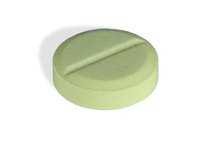Progesterone for Irregular Menstruation
Most women will have an irregular menstrual cycle at some point in their reproductive years. Menstrual irregularities can begin at puberty or when a woman’s reproductive years come to an end, nearing menopause. Other times, abnormal menstrual cycles occur due to medical conditions that cause an imbalance in the sex hormones, such as polycystic ovary syndrome or anorexia. To regulate the menstrual cycle, your physician may prescribe progesterone.
Irregular Menstrual Cycles
During a normal menstrual cycle, the pituitary gland secretes follicle-stimulating hormone, or FSH, and luteinizing hormone, or LH. The release of these hormones causes the reproductive organs to produce estrogen and progesterone. These hormones are on a delicate cycle, which is normally 28 days, according to MedlinePlus. However, problems with the hormones in the pituitary gland can cause a disruption in progesterone by either causing an increase or decrease in estrogen or in progesterone. This may lead to heavy menstrual bleeding, anovulation, short menstrual cycles or spotting between periods.
- During a normal menstrual cycle, the pituitary gland secretes follicle-stimulating hormone, or FSH, and luteinizing hormone, or LH.
- The release of these hormones causes the reproductive organs to produce estrogen and progesterone.
Progesterone
How Long Does it Take Premarin to Work?
Learn More
Progesterone is a hormone secreted by the ovaries around the time of ovulation, which is around week two of a woman's menstrual cycle. Progesterone and estrogen are responsible for the regulation of the menstrual cycle and ovulation. Progesterone, or its synthetic form progestin, is often given to women in the form of birth control pills or along with estrogen replacement therapy to correct the menstrual cycle or decrease heavy bleeding.
Prescription Progesterone
As of 2010, there are four different forms of progesterone that can be prescribed: pills, cream, injection or suppository. Progesterone pills, according to Women‘s Health Resource, absorb into the blood stream in one to four hours 1. You must take this form of progesterone along with food to help with absorption. Progesterone injections are oil based and given intramuscularly; this medication peaks in 12 hours. The suppository cream form is absorbed and peaks within four hours. The progesterone skin cream is absorbed through the skin once a day.
- As of 2010, there are four different forms of progesterone that can be prescribed: pills, cream, injection or suppository.
- Progesterone pills, according to Women‘s Health Resource, absorb into the blood stream in one to four hours 1.
Considerations
How to Regulate a Menstrual Cycle Without Birth Control Pills
Learn More
If you have bleeding after sex, spotting, heavy bleeding, cycles that are shorter than 21 days or bleeding for more than seven days, consider having a blood test to check your hormone levels. According to Dr. Rahim Haloob of Nuffield Hospital, low progesterone can also cause symptoms such as depression and thyroid irregularities 2.
Related Articles
References
- Women’s Health Resource: Progesterone - It’s Uses and Effects
- Dr Rahim Haloob, OBGYN; Essex Nuffield Hospital; Essex UK
- Reed BG, Carr BR. The Normal Menstrual Cycle and the Control of Ovulation. Endotext [Internet]. South Dartmouth (MA): MDText.com, Inc. 2018
- Kumar, P., & Magon, N. (2012). Hormones in pregnancy. Nigerian Medical Journal : Journal of the Nigeria Medical Association, 53(4), 179–183. doi:10.4103/0300-1652.107549
- Norwitz ER, Caughey AB. Progesterone supplementation and the prevention of preterm birth. Rev Obstet Gynecol. 2011;4(2):60–72. PMID: 22102929
- Macias, H., & Hinck, L. Mammary Gland Development. Wiley Interdisciplinary Reviews. Developmental Biology, 1(4), 533–557. 2012 doi:10.1002/wdev.35
- Regidor PA. Progesterone in Peri- and Postmenopause: A Review. Geburtshilfe Frauenheilkd. 2014;74(11):995–1002. doi:10.1055/s-0034-1383297
- Regidor PA. The clinical relevance of progestogens in hormonal contraception: Present status and future developments. Oncotarget. 2018;9(77):34628–34638. Published 2018 Oct 2. doi:10.18632/oncotarget.26015
- Chandra V, Kim JJ, Benbrook DM, Dwivedi A, Rai R. Therapeutic options for management of endometrial hyperplasia. J Gynecol Oncol. 2016;27(1):e8. doi:10.3802/jgo.2016.27.e8
- Backstrom T, Bixo M, Stromberg J. (2015). GABAA Receptor-Modulating Steroids in Relation to Women's Behavioral Health. Curr Psychiatry Rep.17(11):92 doi: 10.1007/s11920-015-0627-4
Writer Bio
April Khan is a medical journalist who began writing in 2005. She has contributed to publications such as "BBC Focus." In 2012, Khan received her Doctor of Public Health from the University of Medicine and Dentistry of New Jersey. She also holds an Associate of Arts from the Art Institute of Dallas and a Master of Science in international health from University College London.









